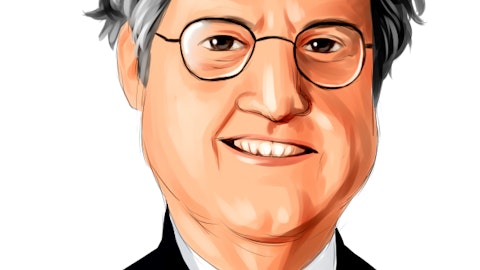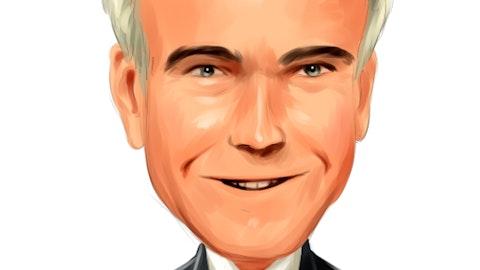Wedgewood Partners, an investment management firm, published its “Focused SMID Cap Strategy” first-quarter 2022 investor letter – a copy of which can be downloaded here. For the first quarter of 2022, the Focused SMID Cap Composite (NET) declined -by 13.2%. The Russell 2500 Index declined -by 5.8%. On an annualized trailing 1-year, 3-year, and inception (6/30/2018) the Focused SMID Cap returned +1.7%, +19.7%, and +15.5%, (NET) respectively. Over the same time periods, the Russell 2500 Index returned +0.3%, +13.5%, and +10.5%, respectively. Try to spend some time looking at the fund’s top 5 holdings to be informed about their best picks for 2022.
In its Q1 2022 investor letter, Wedgewood Partners Focused SMID Cap mentioned Acuity Brands, Inc. (NYSE:AYI) and explained its insights for the company. Founded in 1892, Acuity Brands, Inc. (NYSE:AYI) is an Atlanta, Georgia-based lighting and building management firm with a $5.8 billion market capitalization. Acuity Brands, Inc. (NYSE:AYI) delivered a -20.30% return since the beginning of the year, while its 12-month returns are down by -6.06%. The stock closed at $168.74 per share on May 25, 2022.
Here is what Wedgewood Partners Focused SMID Cap has to say about Acuity Brands, Inc. (NYSE:AYI) in its Q1 2022 investor letter:
“Acuity Brands (NYSE:AYI) is the largest manufacturer and distributor of lighting solutions in North America. The Company is able to generate superior profitability because of its manufacturing scale and vertical integration. Acuity also focuses on consistent product development and improvement that drives attractive performance-to-cost compared to competitors that compete on little more than price. Further, Acuity stands to benefit from a multiyear rebound in spending on commercial building renovations, along with the rise in
U.S. government spending related to the Infrastructure Investment and Jobs Act (IIJA) passed into law in November 2021. Last, the Company’s management has done an excellent job allocating capital since taking the reins in early 2020. We are pleased to have Acuity Brands as one of our Focused SMID Cap portfolio’s largest weightings as it exhibits solid competitive positioning, terrific profitability, an attractive multi-year growth trajectory, and it trades at a cheap multiple.
Acuity competes in the $20 billion North American lighting and building technology solutions industry, with a particular focus on nonresidential projects. The Company generated over $3.5 billion in sales across 2.5 million SKUs during 2021. The backbone of those sales are the Company’s 19 manufacturing plants that can manufacture the most in- demand products in locations closest to customers – 17 plants located in North America – in order to maintain industry-leading service levels. It might surprise you, but none of Acuity’s plants make light bulbs, nor does the Company generate sales from light bulbs. The majority of the Company’s sales are from light fixtures that contain LEDs and drivers that control those fixtures. Acuity also develops sensor-based control systems, which, combined with its fixture and drivers’ business, makes the Company an important customer to many electronics components suppliers. As the need for electronics components has skyrocketed relative to the supply of those components, Acuity’s scale and vertical integration have helped the Company maintain high service levels while expanding gross margins to multiyear highs. Acuity’s vertical integration should help maintain current levels of profitability, despite historically high raw-input inflation, and would expect margins to expand once input prices level out.
Vertical integration also enables Acuity to get more productivity from its research and development (R&D) budget. Although the Company has allocated more to R&D over the past few years, the rest of the company’s SG&A expenses have stayed flat. Acuity spends about 3% of sales on R&D, bringing new products to market and upgrading form factors and capabilities of legacy products. Acuity sources LED chips from third-party suppliers, but a critical benefit of architecting products around LED technology is that new LEDs continue to get cheaper, smaller, and more efficient over time, thanks to process technology optimizations (not unlike what transistors have been doing with CPUs). As a result, every 18 months or so, Acuity can reengineer fixtures with dramatically smaller form factors (in some cases 80% smaller). More recently, given the emergence of input inflation, a smaller fixture form factor has helped Acuity reduce input costs while also providing a better experience for architects and installers. The Company’s manufacturing footprint is tightly integrated with its design teams, so product upgrades are constantly layered in and can be quickly released to market. As a result, the Company brings about 75 new products to market every year. Importantly, the quality of Acuity’s fixtures is also of paramount importance, because these fixtures need to last for a decade or more. Acuity issued zero product recalls in 2021 and had no losses related to product safety and spent less than 1% of revenues on product warranty costs. Acuity’s manufacturing and design capabilities should continue to serve as key differentiators for the Company.
Approximately two-thirds of the global building stock that will exist in 2040 has already been built, so the majority of Acuity Brands’ commercial focus is on retrofitting these existing spaces with better technology. An important component of retrofitting demand is the need for businesses to reduce their carbon footprints. According to Architecture 2030, building operations generate 28% of global CO2 emissions every year, and lighting is a significant component of these emissions. According to Acuity’s SASB (Sustainability Accounting Standards Board) Index disclosure, 85% of the Company’s revenues are derived from efficiency-related products. Acuity should be able to outgrow the general construction spending market, as efficiency projects become the focus of many businesses, thanks to the recently enacted IIJA. For example, the IIJA provides the Department of Energy with $500 million in grants to public schools for energy efficiency upgrades. The legislation also provides another $550 million in grants to state and local governments for projects that also focus on reduction of fossil fuel usage and energy efficiency. We would expect demand to remain robust for the foreseeable future and expect the Company to be able to deliver high single-digit revenue growth.
Neil Ashe was appointed CEO of Acuity in February 2020 and has done an excellent job navigating Acuity back to historically strong gross margins, particularly in the face of end- market turmoil driven by COVID and the ensuing raw input inflation surge. Since September 2020, the Company has repurchased 12% of total shares outstanding at a weighted average price of around $118 and an average forward multiple of around 14X. As estimates have moved higher because of solid execution, Acuity currently trades close to 14X forward earnings, so we would expect management will continue to be aggressive with repurchase activity. These repurchases, along with margin expansion from solid competitive positioning and healthy revenue growth, should drive strong double-digit earnings growth at Acuity.”

Pola Damonte/Shutterstock.com
Our calculations show that Acuity Brands, Inc. (NYSE:AYI) fell short and didn’t make it on our list of the 30 Most Popular Stocks Among Hedge Funds. Acuity Brands, Inc. (NYSE:AYI) was in 29 hedge fund portfolios at the end of the first quarter of 2022, compared to 26 funds in the previous quarter. Acuity Brands, Inc. (NYSE:AYI) delivered a -1.80% return in the past 3 months.
In January 2022, we also shared another hedge fund’s views on Acuity Brands, Inc. (NYSE:AYI) in 5 Stocks in Focus After Releasing Their Financial Results. You can find other investor letters from hedge funds and prominent investors on our hedge fund investor letters 2022 Q1 page.
Disclosure: None. This article is originally published at Insider Monkey.





